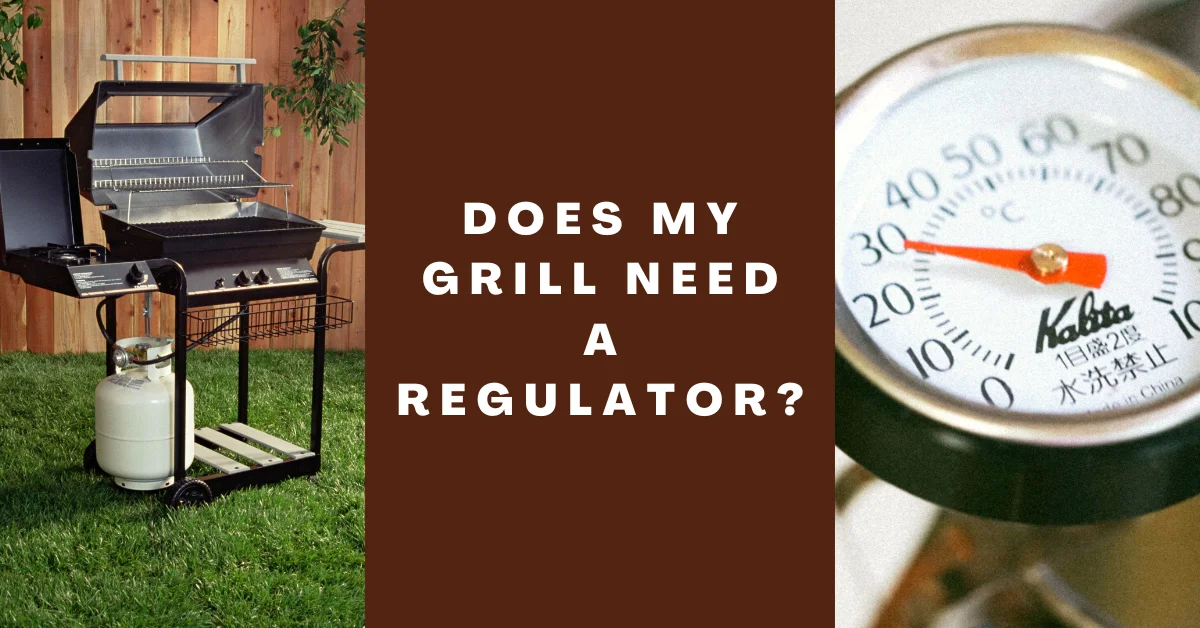If you are a BBQ enthusiast, you must know that a good grill does the trick. What if you have planned an enormous BBQ party, but the flames seem to be very low right before cooking, and the temperature seems to be below the desired one. How do you fix this problem? With a regulator, of course. But does your grill actually need a regulator?
This article will help you find solutions to most grill-related problems. It will also detail the proper use of a grill regulator. What are you waiting for? Read on!
Does my grill need a regulator?
Yes, all gas grills need a regulator to ensure smooth working. The only time when your grill doesn’t need a regulator is when it is directly attached to the house’s propane system.
Gas grills require regulators to work efficiently and keep from disasters such as gas leaks, etc. There is also more than one type of regulator; you can choose according to your preference.
Why does my grill need a regulator?
A gas regulator has three main functions; it controls the gas flow to the grill’s heating mechanism, serves as a safety between the grill and the gas tank, and helps regulate the pressure to your grill.
Gas supply lines are sometimes not regulated, and sometimes, there may be periods of surges that might mess up the pressure. Therefore, it is essential to use a regulator to ensure that your grill receives an even flow of gas pressure.
How does a gas regulator work?
The gas enters the regulator and fills up the valve chamber. When you turn the control knob, gas pressure moves the diaphragm downwards. Then the gas enters the low-pressure chamber, which stabilizes the diaphragm by pushing upwards. Later, the pressure drops, and the outlet pressure rises. Gas leaves the regulator when you turn the valve off or the cylinder empties.
To fully understand the need for a regulator, you should know what a regulator is and how it works. Knowing so is important to save yourself from any disasters in that upcoming BBQ party you are arranging.
Components of a regulator
Before we move on to the details of these steps, which brief you on the general working of a gas regulator, we must inform you of the components that make up a regulator. A regulator is made up of the following apparatuses:
- A spring, which is more commonly known as the adjusting spring
- A diaphragm, which is a metal disc or sometimes a thin, flexible rubber
- A valve
- Some regulators consist of valves too
Keeping these components in view, we’ll detail the entire workings of a gas regulator so you can better understand its purpose.
The working of a gas regulator
STEP 1: Entry of gas into the regulator
The regulator is first attached to a gas cylinder. Then the valve is opened, and the gas enters the valve chamber through an inlet. This gas is usually high-pressure compressed gas.
STEP 2: Filling of chamber
This high-pressure compressed gas then fills up the entire valve chamber. An inlet gauge indicates this.
STEP 3: Diaphragm moves downwards
If you want to increase the gas supply flow, you will have to turn the regulator’s control knob clockwise. Turning the knob clockwise will put downward force on the spring, bending the diaphragm towards the downside. Doing so will ultimately push open the valve stem.
STEP 4: Gas enters the low-pressure chamber
The valve stem that has been pushed open allows the gas to flow into the low-pressure chamber. A contradictory force on the spring will be created as the gas will now push against the diaphragm upward.
STEP 5: The stabilization of the diaphragm
The diaphragm steadies and eventually stops moving, which allows the gas to flow into your appliance more smoothly and at an even rate. This stabilization results from the equalizing effect of the upward force of the gas on the diaphragm and the downward force the spring is exerting.
STEP 6: Pressure in the cylinder drops
As the gas starts to get used up, the pressure in the chamber starts to fall consequently. This effect is carried on to the valve chamber, where the pressure also starts to weaken.
The diaphragm starts to move down from the spring’s force, making the low-pressure chamber fill up with more gas as the valve now has a broader opening.
STEP 7: Rise in outlet pressure
The high gas concentration in the low-pressure chamber causes the outlet pressure to start rising, which can be seen on the gauge. There is little to no gas left in the inlet.
STEP 8: The cylinder empties
In case the cylinder runs out of gas, or you voluntarily turn the cylinder valve off because you are done using your grill, the regulator’s inlet shuts off. As the last remnant of the gas leaves the regulator, both the pressure gauges return to zero.
What types of gas regulators are available?
Different types of gas regulators are available, which are used according to the requirements of every appliance. Some grills may require the use of multiple regulators to increase their efficiency.
Now that you know how a gas regulator works, the next question is, what kind of regulator does your grill require?
To answer this question, you need to understand that all regulators serve the same purpose, but they are not the same in composition. A regulator’s function may remain the same, but different setups will need different kinds of regulators.
The following are some types of gas regulators you can easily find:
- High-Pressure Regulators
- First Stage Regulators
- Second Stage Regulators
- Integral Twin Stage Regulators
- Appliance Regulators
What to consider before selecting a regulator?
When deciding on a specific type of regulator for your grill, you need to look for factors such as; quality and type of material used for the build of the regulator, inlet & outlet pressure capacity, the BTU requirements, pressure requirements based on the main pipeline, and the type of fluid used inside the regulator.
You need to be aware of numerous factors before you can decide the type of regulator for yourself. The following five factors will help you narrow down your choices, making the decision-making process more straightforward.
1. Type of material used
You should always keep in mind what the operating environment for the regulator will be before you decide on the material.
For instance, if the gas environment where the regulator has to work is corrosive, a stainless-steel regulator would be better suited than a brass or plastic one. If you are looking for an affordable gas regulator, plastic may be your go-to choice.
2. Inlet pressure & outlet pressure capacity
Different applications have different inlet pressure requirements. Therefore, while getting a regulator, make sure the pressure you require can be handled by the said regulator well.
Similar to the inlet pressure, the outlet pressure should be compatible with the pressure requirement of the equipment connected to the regulator. Make sure to look out for this.
3. BTU (British Thermal Unit) requirements
The capacity of an appliance using gas is based on BTUs. Before selecting a regulator for your grill, you need to know the total BTUs required by the appliance or the rough number of BTUs you would expect to use with the gas regulator.
4. Pressure requirements
You need to make sure you install the correct type of regulator that is best suited to the kind of gas pressure your main pipeline delivers. Installing a regulator with an excessive flow rate could waste gas and result in flooding, whereas using a low flow rate may strain the supply.
5. Type of fluid used
This factor essentially refers to the kind of environment your regulator will be working in, whether liquid or gaseous. Sometimes, steam is also an option, but it serves no purpose when it comes to grills.
When should I replace the grill’s gas regulator?
Experts recommend replacing your gas regulators every 15-20 years (due to wear and tear), especially if your grill has started running into problems with the flow of gas. You should also replace the gas regulator if any internal regulator issues arise.
It is of utmost importance to note here that gas regulators are always replaced and never repaired. This is because the workings of a regulator are too minuscule for repair. Therefore, it is always better to replace it.
You may face several regulatory issues, so it is always important to educate yourself on what could be disastrous and how to mitigate that danger. The following are the possible causes for any regulator issues:
1. Gas leaks
A gas leak is the most common and dangerous regulator issue that people face. You need to immediately turn off the gas supply and remove the regulator to mitigate this danger.
Spraying soapy water around the regulator while the valve is on will help identify any leak as bubbles will start to rise. This is a clear sign that you need to replace your regulator.
2. Broken bypass mechanism
The flow of gas to your grill is regulated by a piece of apparatus called the bypass. Your regulator may need to be replaced if your bypass automatically turns off the gas.
3. Tight/ loose regulator
Many regulator issues occur when people forget that any adjustments to a regulator need to be made by hand and not with a wench. In case your regulator ever gets stuck, it’s always a good option to use a lubricant instead of using a wench, which may cause permanent damage.
Summing it up
By now, you must have learned that your grill needs a gas regulator; otherwise, a hazard might be right around the corner and may go unnoticed by you. A regulator helps bring a smooth and even flow of gas to your grill and helps serve as a mechanism of safety between the flame and the gas supply.
We hope now you are well educated to choose a suitable gas regulator for yourself. Don’t forget to replace those old regulators and keep an eye out for any regulator issues that may need your attention.



